Author: Xin Su
Introduction
In the late 19th century, when anti-Chinese violence in California was in full swing, many Chinese began to migrate to other parts of the United States in search of an easier life. It was at this time that Woo Yee Sing (1862-1925) moved to Minneapolis, Minnesota. He and his brother, Woo Du Sing, founded the first Chinese restaurant in Minneapolis called Yuen Faung Low (also known as John’s Place). Sarah Mason, a historian from Minnesota, interviewed Howard Woo, Yee Sing’s son, on October 9, 1981, and Margaret Woo Chinn, Du Sing’s daughter, on May 27, 1982, respectively, leaving us valuable first-hand information about the history of Chinese Americans in Minnesota. The author of this article interviewed Honnay Molloy, Du Sing’s granddaughter. Here, the author wishes to thank Molloy for her tireless explanations and her insights into her family’s story.

Picture 1,The original sign that hung outside Yuen Faung Low, now kept at the Minnesota Historical Society.
Sow a Seed and the Earth Will Yield You a Flower
After 83 years of accolades and service to its community, John’s Place closed its doors in 1967. Today, more than 50 years later, as Minnesotans can only find the plaque of Yuen Faung Low (John’s Place) in a museum, many can still recall fond memories of distant days when the restaurant was still open. The following are conversations recorded in Facebook about their experiences at John’s Place.
- “John’s Place was amazing—I was still a child when it closed, and it was very hot and sunny and the line stretched down the block to get in for the last meal.” (Jill Johnson)
- “John’s place was my favorite restaurant when I was a kid. I was sad when it closed and took my mom there for her Birthday right before it closed.” (Shayne Ratner)
- “I am transcribing my grandmother’s journals 1930’s and she mentions John’s Place. Usually getting chow mien. But always good she said. She ate their often over the year“ (Kimberly A Ahern)
- “I remember my father taking me to John’s when I was about 12 or 13 yrs old.”(Bonnie Hultman Burns)
- “This is a picture of the Chinese restaurant called John’s Place, that Grandma was telling you about. The first place that she and Grandpa first had Chinese food.” (Jacob Hippensteel)
- “John’s Place was the best. My grandparents went there and so did I in 1962.”(Mary Lorvick)
- “My family ate at John’s many times in the late 1950s early 60s. It was my favorite place to go in downtown Minneapolis. As I recall, the restaurant was on the second level.” (Bob Crouse)
- “I remember many family dinners at John’s Number One Son, the follow up restaurant to John’s Place. My father told me John’s Place was popular with his Japanese American friends in the late 40’s and that Charlie Woo sponsored sports teams.”(Randy Kirihara)
- “John’s Place was the best. My grandparents went there and so did I in 1962.”(Mary Montana-Loveless)
- “First Chinese restaurant I’d eaten in 1964. Never found one better.” (Doug Pfeil)
- “John’s Place had the Best food. I loved their Chicken, 1963-67. It was my favorite. Really very nice dining room.” (Connie Ranning)
- “Went there often as a kid. My mother worked there. Beautiful layout, great food.”(Wally Warhol)
- “I loved John’s Place and how well they treated us, your best friends!”(Francie Anthony)
- “As a carpenter/woodworker I love the details and skill needed (for the plaque).” (Douglas Menning)
- “The sign (of the plaque) is an amazing work of art.”(Joan Tighe)
- “OMG! We used to go to John’s Place twice a year with all seven of us! Walking up the stairs and coming into the restaurant was magical! Besides being the best Chinese food ever“(Lynn Prokop)
- “A 80 year old resident I take care of reminiscing about furniture. What happened to furniture, any ideas?“(Cindy Diggins Garcia)
- “The most amazing restaurant!!! Up the steep stairs to paradise!”(Cynthia Noren)
After reading these comments, we can imagine what a paradise-like restaurant looked like in the mind of generations of Minnesotans.
John’s Place was located on a bustling second floor in downtown Minneapolis. On the shiny golden plaque, three bold characters, “Yuen Faung Low”, were unusually eye-catching; the interior decoration was antique-styled, exquisite, imported, clean, and elegant. The dining tables were Chinese square teaks with gray-white marble tops. Table legs and frames were inlaid with ornately decorated flowers, and mother-of-pearl birds, embroidered fabrics, and carved panels from China. It was more like a family restaurant. John’s place separated the bar from the restaurant and no jarring music played in the background. The restaurant had nice decor and provided private partitioned booths if you were on a date or had small kids.

Picture 2,The interior of John’s Place.

Picture 3, A dining table used at John’s Place
Talking about the glorious history of John’s Place, Du Sing’s granddaughter, Honnay Molloy said,“John’s Place had great service and loyal customers. The food was high quality and all made from scratch. The beef dishes were made from tenderloin filet. There were attorneys from the Plymouth building came for lunch 3-4 times a week and ordered the steak sandwich. John’s Place was successful because it was large, established, had a central downtown location, and had a full American menu too.【1】”
John’s Place was more of a family restaurant, but it had scientific management. Many of their servers had been with the restaurant for more than 25 years.【1】
One of the waitresses said, “The most amazing restaurant!!! Up the steep stairs to paradise! The family became a part of my life when I was a waitress at John’s Number One Son restaurant in Golden Valley on highway 12. The Wong and Woo families! Joy! 1966-1968!” (Cynthia Noren)
The Woo brothers started out from scratch and founded the first Chinese restaurant in Minneapolis in 1883. They raised a large family and helped many Chinese immigrate to the United States from their hometown, Kaiping in Guangdong province. Chinese immigrants took root and grew in the land of Minnesota, generation after generation.
Woo Yee Sing Settled in Minnesota
Woo Yee Sing originally arrived in the United States in San Francisco. His first job was building railroads for the Union Pacific Company. In 1882, he, along with several others, moved to Minneapolis, Minnesota in search of a better life【2,3】.
Minnesota has 79,205 square miles of land. It had a population of 780,773 people in 1880, resulting in a population density less than 10 people per square mile of land. 99.5% of the population was white. The remaining 1,564 people were recorded as colored, 2,300 Indians, 24 Chinese, and 1 Japanese. There were only two Chinese recorded in Hennepin County, where Minneapolis is located. 【4】
It is often said that Minnesota has only two seasons: winter and construction (the roads damaged by heavy snow in the winter can only be repaired during the summer). Winters are brutal, and sometimes the snow season begins in October and runs until April. When storms hit, the cold weather makes it almost unbearable for outsiders.
The weather was the same back in the 1880’s. Woo Yee Sing grew up in the warm, tropical climate of Guangdong and endured some of the worst winters in Minnesotan history. Several record-breaking snowstorms in those years are well documented in historical data. Among them, the 1888 “child blizzard” was the most shocking. The blizzard lasted from January 6 to 11, trapping thousands of people, including many students at school. Between 250 and 500 people froze to death during the storm. 【5】
Despite the harsh weather, not knowing anyone, and not speaking English, Woo managed to take root in Minnesota.
Woo cut off his long queue and integrated himself into his new country. He attended Westminster Presbyterian Church (1200 First Avenue South, now Marquette Avenue), where English classes were offered. There Woo Yee Sing learned how to speak, read, and write English【2】.
The first shop opened by Yee Sing was a hand laundry store (Thirteenth Street and Nicollet Avenue). In 1883, Yee Sing also opened a restaurant called Canton Café (231 First Avenue South). This was the first Chinese restaurant in Minnesota history【2】.
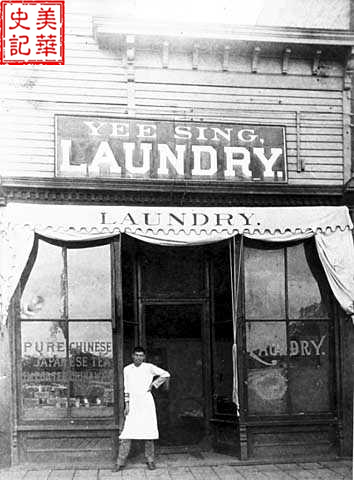
Picture 4,Woo Yee Sing in front his laundry business circa 1895. The business stayed at this Nicollet Avenue address until 1913. 【2】
Yee Sing was the fourth of the five children in his family. After he settled down, he began to bring his relatives from his hometown to Minnesota. In 1884, his second brother and fifth brother, the previously mentioned Woo Du Sing, arrived to join the family business. The two took a Chinese Clipper and drifted for several months, eventually arriving in in Minnesota from Kaiping. The elder brother was was obligated by Chinese tradition to help raise the family, so after a short stay, he returned to his hometown to take care of the family elders and youth. The youngest brother Du Sing stayed and worked with Yee Sing. 【7,8】
Around 1885, Yee Sing became a leader of the Chinese community of 75 to 80 men,【2】 and he was regularly interviewed by newspaper reporters【9】.
Woo Brothers Established a Family
Most Chinese who came to the United States at that time were single. There were no Chinese women in Minnesota in 1880’s. Typically, men who reached their marriage age would return to China, get married, and have kids while still in China. The men would then return to and work in the United States , sending money back to support their families. Woo Yee Sing, whose business was thriving at this time, decided to return to Guangdong in 1892 to search for a wife. However, hearing that the San Francisco Presbyterian Mission Home had rescued many Chinese girls who had been abducted in poor rural areas and smuggled to America, Yee Sing decided to try his luck there first.【2】
Yee Sing was a handsome man and behaved gently. His presence excited the mission home director, Margaret Culbertson, who introduced him to the beautiful 21-year-old Liang May See (1871-1946). The couple fell in love at first sight. 【2】
Liang May Seen was also from Kaiping, Guangdong. In 1885, at the age of 14, she was trafficked to San Francisco as a sex slave for the rich. The Presbyterian Mission Home rescued her on July 21, 1889. 【2】
Following the usual procedure, a staff member at the Presbyterian Mission Home contacted the pastor of the Westminster Presbyterian Church at Minneapolis that Yee Sing attended and confirmed that he was a Christian with good characters. On July 21, 1892, on the third anniversary of Liang May Seen’s escape from the brothel, the two married. Their wedding was presided over by the pastor of the Chinese Presbyterian Church at San Francisco (I.M. Condit) with Director Culbertson as the witness【2】.
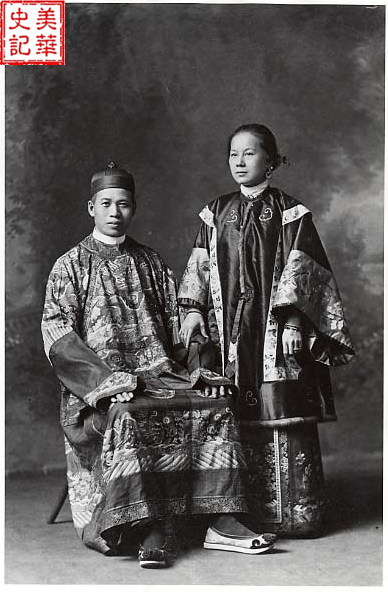
Picture 5,Wedding portrait of Liang May Seen and Woo Yee Sing, 1892【2】
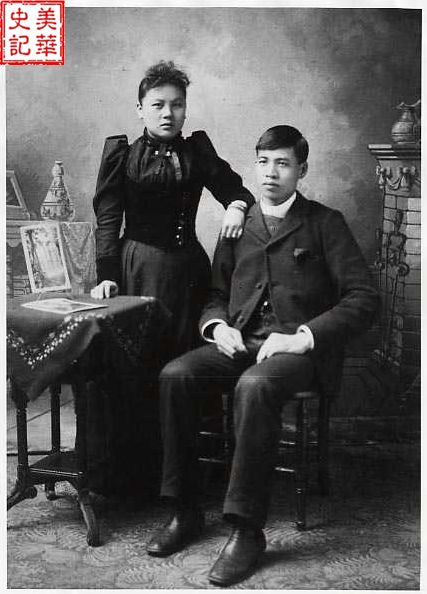
Picture 6,Honeymoon portrait, taken when Liang and Woo visited the Columbian Exposition, Chicago, 1893【2】
Liang May Seen came to Minnesota with her husband in 1892 and became the first Chinese woman in Minnesota.
In 1893, Culbertson fell ill and her assistant, Donaldina Cameron, became the contact of Yee Sing and May Seen. Together, they served as a bridge for other Chinese bachelors and girls at the Presbyterian Mission Home and helped Chinese men get married. The Woo couple was active at the Westminster Presbyterian Church, attending the Church’s English courses and Sunday services and organized and led activities for the community【2】.
In 1904, Liang May Seen opened a curio shop. For the convenience of church service, the couple chose to open the store at 12th and 13th Streets, not far from the Westminster Presbyterian Church【2,8】.
The only pity to this family was that the couple did not have a child for many years. In 1906, with Cameron’s help, the couple returned to San Francisco and adopted a little boy named Howard. Howard was born in San Francisco on November 17, 1905. They returned San Francisco in 1926 for the birth certificate with Cameron as the witness【2,10】.

Picture 7,Liang May Seen with her son, Howard. Photograph by George M. Dempsie, c. 1910.【2】
Woo Du Sing, instead of following his brother’s footsteps, returned to his hometown in 1900 and got married. Under the terms of the Chinese Exclusion Act, a merchant was allowed to bring their family to the United States, so in June 1914, Du Sing brought his whole family, a pregnant wife, 12-year-old Charles, and 18-month-old Margaret, from Kaiping to the United States. 【2,8】
At the beginning, the two brothers and their families lived together in Minneapolis (Yale Place and Twelfth Street) with Du Sing’s family upstairs and Yee Sing’s family downstairs. This continued until 1922 when Yee Sing bought a house on 25th Street and Aldrich. Two years later, Du Sing settled his family in a new house at 1618 Clinton Avenue. 【8】

Picture 8,The residences and businesses of Woo Yee Sing, Liang May Seen, and family, as well as other Chinese laundries in Minneapolis’s downtown area, 1885–1967. Note also the three locations of Westminster Presbyterian Church.【2】
John’s Place
Yee Sing had a Jewish friend named Isaac Weil. Weil had a liquor store on Fourth Street, but he built a new building on Sixth Street, where the legal boundary was for liquor, in case he had to move his store. At the time, Weil wanted to find a tenant, so he suggested to Woo Yee Sing to open a restaurant in the new building. At this instigation, in 1905, Woo moved Canton Café to the second floor of the Weil’s Building on 6th Street and renamed the restaurant “Yuen Faung Low”【10】. Yuen Faung, meaning exotic fragrances from afar.
To bring good luck to the new business, the Woo brothers bought five-piece altar set from Guangzhou in 1910 and placed them in the dining area【11】.
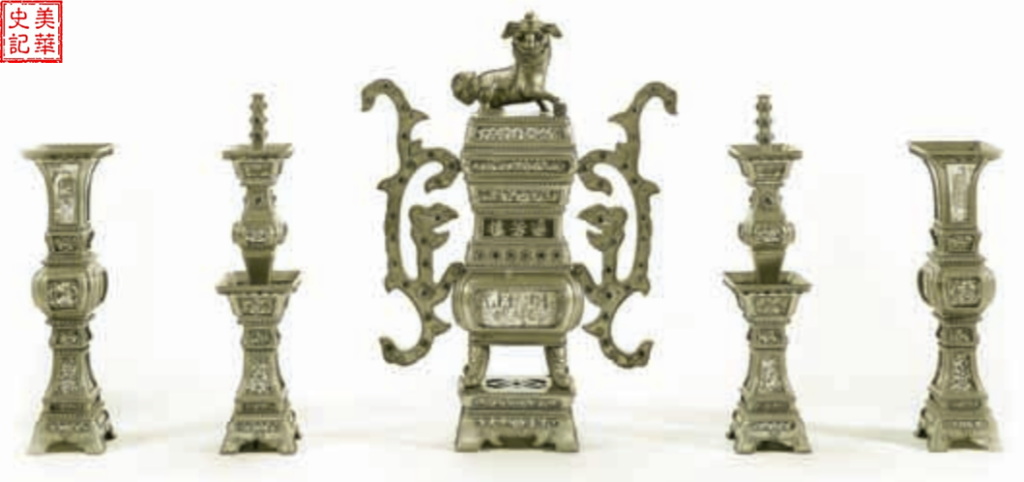
Picture 9,Crafted specifically for the restaurant and purchased in Guangzhou (Canton) around 1910, the set consists of two flower vases, two candle holders, and a tiered incense urn.
Yee Sing mainly interacted with customers, and Du Sing worked in the kitchen【8】. Initially the menu was simple Chinese dishes, such as noodles, but also had Western dishes, such as pork chops, steaks, and potatoes. 【1】
The Woo brothers’ business grew gradually, and they took advantage of their connections with businessmen in Hong Kong to start an import company, “Yee Sing and Company”, which imported food for restaurants. The company was located on 2224 West Avenue (later Glenwood Avenue) and successfully operated until the Great Depression【10】. When the family’s business became too busy, Liang May Seen closed her antique shop in 1912 and became a full-time housewife, cleaning the house and sewing clothes. 【2, 8, 10】

Picture 10,Woo Du Sing in his brother’s import store, Yee Sing and Company, on Western Avenue, 1920s.【2】
In 1916, the restaurant advertised the addition of a second-floor tea room “for ladies” that catered to “a strictly high-class clientele.”【9】
John’s Place was soon booming with the hard work of the two brothers. Soon, they expanded the business downstairs and opened a bar. Yee Sing’s son Howard proudly said, “Right underneath the restaurant, we had the longest bar in Minneapolis. It was one of these old-time bars that extended all the way from Sixth Street down all the way to the alley. “【11】
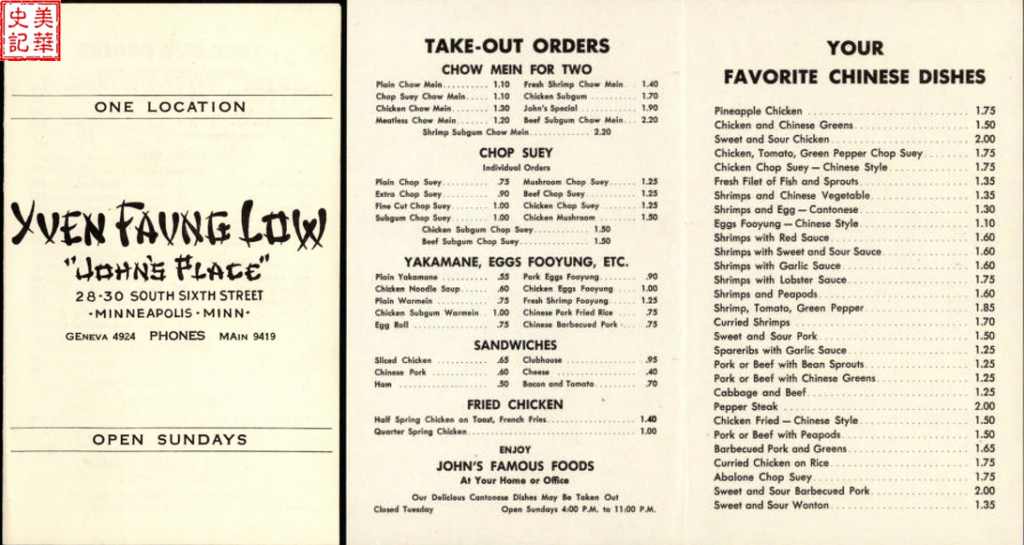
Picture 11,Menu
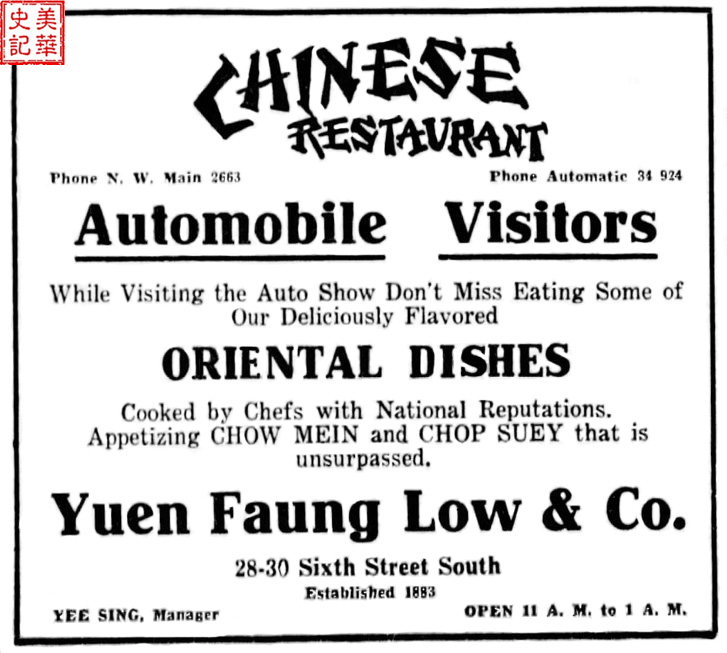
Picture 12,1916 advertisement
Were There Racial Discriminations in Minnesota?
Minnesota opened its arms and welcomed the Chinese when the West excluded them. The mainstream culture in Minnesota was polite, modest, respectful, and friendly. However, some people were still racially biased or discriminated against the Chinese.
At that time, the Chinese community was a small group: three families in Minneapolis and three in its twin city, St. Paul. These Chinese families often visited each other, traveling one hour by bus or half an hour by train. 【10】
Yee Sing was a prominent and popular figure in the local area, which exposed to attacks. At that time, his pastor defended him against those who physically assaulted him saying in 1890 that Yee Sing was “a thorough business man, a gentleman and a Christian, and one of the best members of my church. In my opinion he is better than 90 per cent of those [who] are so vindictively persecuting him.”【9】Anti-racists were rare among all communities at that time, but his pastor was one of those. Yee Sing was undoubtedly a pioneer in the fight against racism as well.
In 1902, Woo Yee Sing was interviewed by a reporter from the Minneapolis Journal. The reporter observed that at the four Chinese restaurants in Minneapolis, a black patron “gets just as cordial a greeting from the proprietor as is accorded to a white man.” Woo replied, “And why shouldn’t they? They are men like you or me. They have got to eat and there must be some place for them to do so.” He looked around his restaurant, observing, “They are all brothers, and there is no room for race prejudice.” 【9】
The Canton Café was attacked by the cooks’ union in 1902 and accused of paying chefs too low, which made difficult for the restaurants operated by white owners to compete at the same low prices. They asked union members to boycott Canton Café and other Chinese restaurants. Yee Sing opposed the union’s claim and called this was “the old California cry” [i.e., propaganda].【9】
Yee Sing acquired his citizenship early on, and the head of the cooks’ union disliked hearing Woo claim that he was a citizen and complained to a reporter, “It is silly to hear him talking of being a naturalized American citizen. All know why a Chinaman gets naturalized – not for love of the country, but for the lust of gold.” 【9】It can be seen that although Minnesota was far from the violence in the West, racial discrimination still existed.
“In 1921, somebody planted a bomb. It damaged the front and the stairway and everything was just piled down. It didn’t hurt the kitchen or the back end.” Yee Sing’s son, Howard, recalled the incident in the 1981 interview, “So terrorism isn’t anything new around here, or racism isn’t either.” 【11】When Howard studied at the University of Minnesota in 1922, social groups, fraternities, and academic groups still did not accept Chinese participation. 【11】
Chinese Cemetery at Minnesota
The Woo brothers often went to the Western United States. In 1925, after a trip to Seattle by train, Yee Sing fell ill and was diagnosed with liver cancer. The disease developed rapidly, and he died a few months later at the age of sixty-three. He left an estate valued at $41,200, and he was the first “Chinese” who filed a will in Hennepin County probate court.【9】
His funeral, attended by 700 people, was a cross-cultural event that incorporated Chinese and American customs【9】. A Christian memorial ceremony was held at his church then followed by a Chinese funeral. The family hired a band on Nicollet Avenue, and 25 people played Chopin’s “Funeral March”, touring where he lived and worked, through West Avenue (now called Glenwood Avenue) and finally reaching Lakewood Cemetery (3600 Hennepin Avenue) where he was buried. Following him, a few bachelors, who worked with Yee Sing for many years, were later buried in the Lakewood Cemetery after their deaths. 【8,9】
Du Sing died of blood poisoning at St Barnabas Hospital at the age of 67 in 1934. The death of the kind, tolerant, and generous “godfather” was a great shock to the Chinese community in Minnesota. Westminster Presbyterian Church held his memorial service. In accordance with Chinese tradition, the family distributed sugar cubes to the crowd and used sweetness to drive away the bitter taste of the funeral.
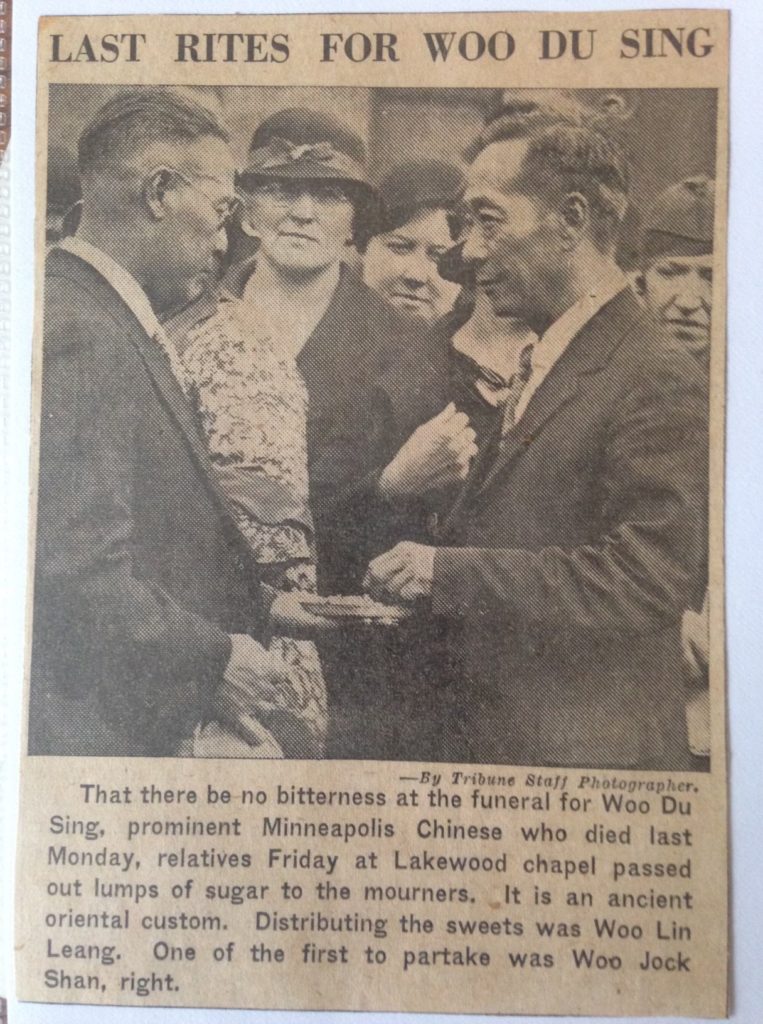
Picture 13,Photo from Honnay Molloy.
The press said, “The great mountain must crumble. The strong beam must break. The wise man must wither away like a plant”.【10】
Thousands of people stood on the streets to bid farewell to the respected Chinese restaurant owner. The funeral procession made three stops, John’s Place, Seafood Grill (2913 Hennepin Ave, another restaurant owned by Du Sing), and his house, before arriving at Lakewood Cemetery.
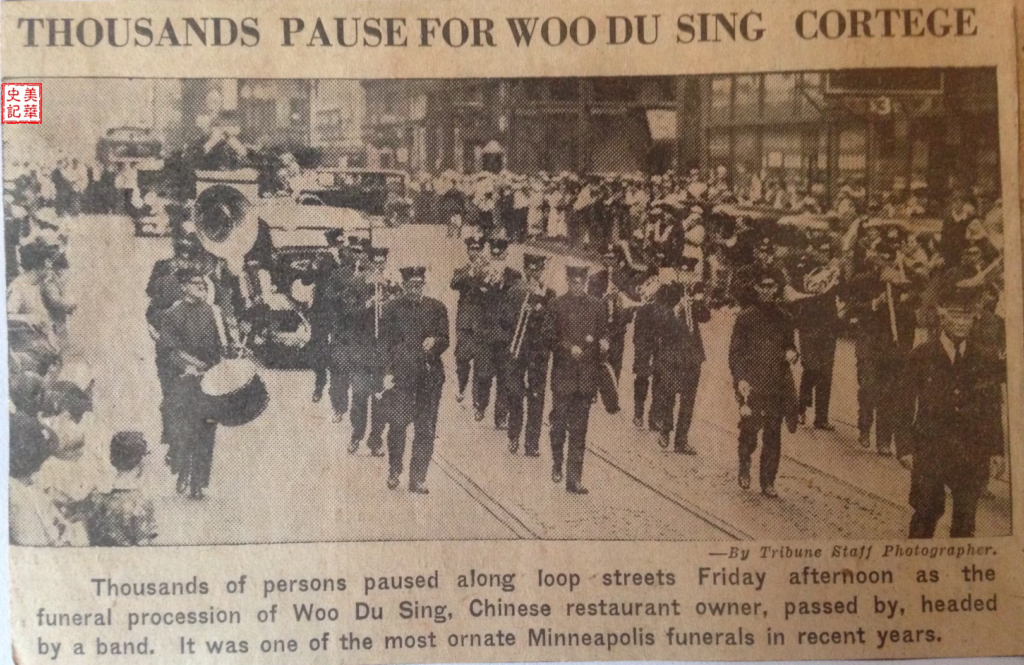
Picture 14,Photo from Honnay Molloy.
Du Sing’s body was temporarily kept at Lakewood Cemetery after the funeral. A year later, in 1935, his family brought his body back to China on a 26-day’s voyage with the Canadian Pacific Company. Back home, his family held a solemn funeral for him, and guests from all directions held banquets in accordance with local customs for up to a week. Du Sing spent most of his life in the United States and was eventually able to return to his roots【8】.
After the funeral, Du Sing’s wife never came back to the United States. Her hometown in Guangdong was still very primitive. Her family was the first to build a house and to have running water【8】.
Liang May Seen died in 1946 after a year and a half battle with heart disease. She was buried with her husband at the Lakewood Cemetery. 【8】Their children, including Howard Woo and Lolita Young, Du Sing’s three children and spouses (Charles Woo and Bessie, Margaret Woo Chinn and Howard Chinn, William Woo and Jeanne)were buried there as well.
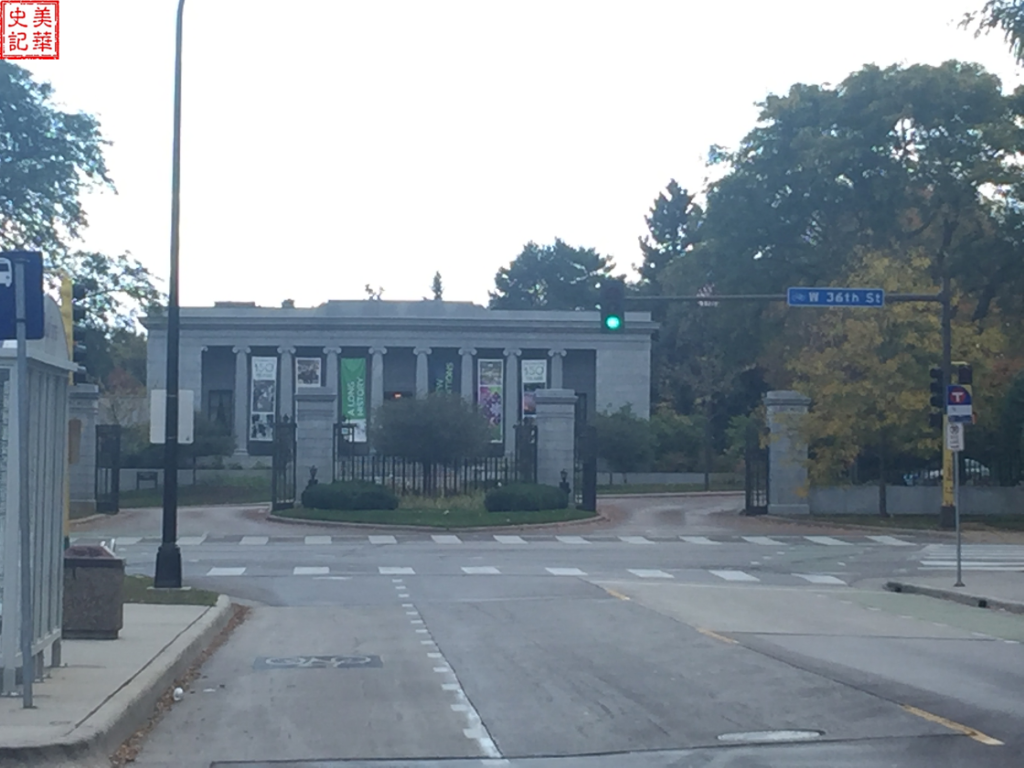
Picture 15,Lakewood Cemetery. Picture taken by author.
The place where ancestors are buried makes a connection between generations of immigrants. Many early immigrants from Guangdong were buried in the Lakewood Cemetery, Minneapolis. Their children and grandchildren are connected to this piece of land, forever.
The Growth of the New Generation of the Family
After Yee Sing’s death, first Du Sing started to take charge of John’s Place soon followed by Du Sing’s eldest son, Charles Woo【8】. The menu also changed from family style to gourmet food.【1】
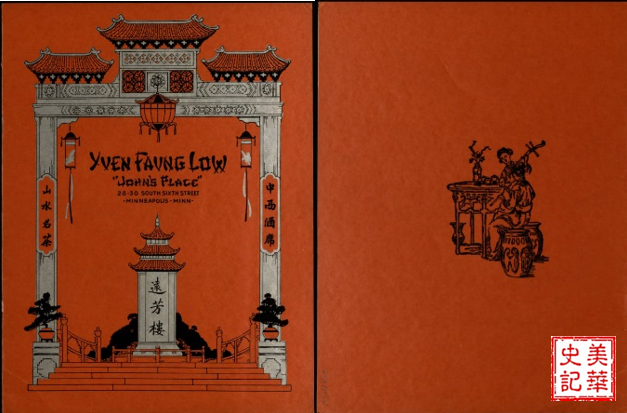
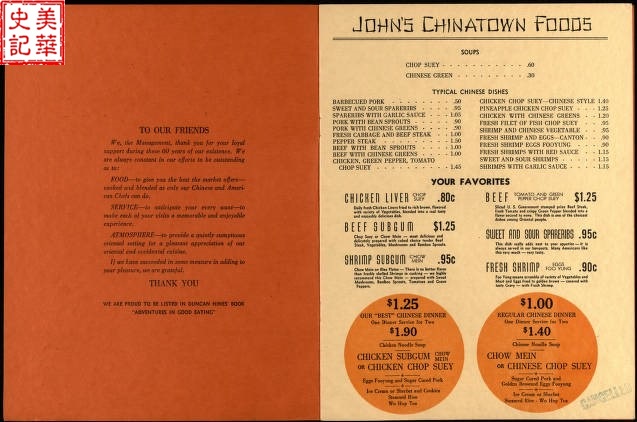
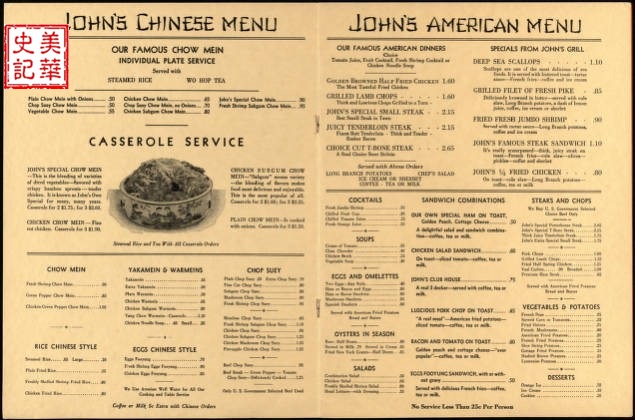
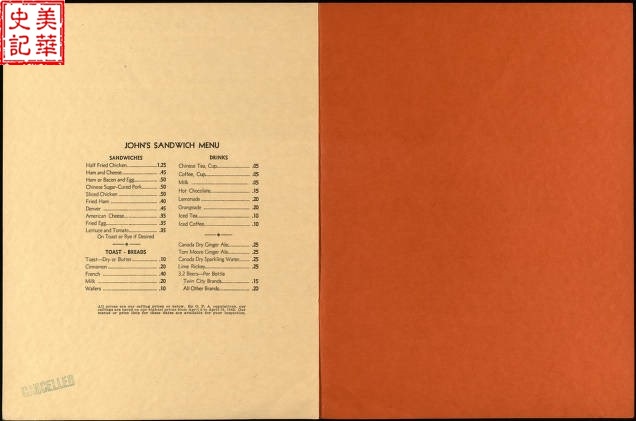
Picture 16, Bi-fold booklet menu. The prices were dated for 1943. https://digitalcollections.hclib.org/digital/collection/Menus/id/1379
John’s Place is a family business, so the entire family, except Charlie’s wife (Bessie Woo), had worked in the restaurant. Children were not allowed to go to the family restaurants when they were young. They set clear boundaries between business and family life and did not want children to interfere with the restaurant business. Margaret, Du Sing’s daughter, recalled taking her friends to restaurants when she was young. While most of her friends ate Western food, she ate both Chinese and Western food. 【8】
Growing up, the children began to join the restaurant business; high school children worked after school as cashiers but also helped in the kitchen. Honnay Molloy, Du Sing’s granddaughter said, “I worked there in the summer of my junior year in high school and I actually got paid. But I learned to “help” once in a while, and knew how to be cashier, stocked the candy display, took phone orders back to the kitchen, etc.”【1】
Du Sing’s two sons (Charles and William) and daughter (Margaret Woo) participated in the family business without completing college. 【8】Yee Sing’s son, Howard, exceled in his studies and earned two bachelor degrees at the University of Minnesota. One of his friends, an America-born Chinese, Kim Wah (known as Walter James) opened a restaurant called Nankin Cafe in 1919, which ran successfully for more than 80 years. James also started a company (Kim Wah Company). At that time, it was still very difficult for Chinese man to marry a Chinese woman. By chance, a woman named Lolita Young graduated from Oregon Business School (Portland) and joined James’ company. Lolita later married Howard in 1931 after Howard’s college graduation. 【11】
After Howard had started his family, he worked as a product engineer of the Twin City Ordinance Plant. Later, he worked at the Maico Corporation, a company that made hearing aids and had a contract with the government to develop metal detectors for hospitals to detect shrapnel in the bodies. At the same time, he worked part-time at John’s Place as a cash register and manager. During this time, John’s Place was mainly run by Du Sing’s eldest son, Charlie. It wasn’t until 1956-57 that Howard started to work at John’s Place for full-time. 【11】 Howard’s wife (Lolita Woo), the son of Yee Sing’s elder brother (Donald Woo), and the son of the former chef (Jack Hong Jue) were all in charge of the business.【12】
When John’s Place was reorganized, Du Sing’s son, Charlie, opened a restaurant, the White House, in St. Louis Park and then a branch (John’s Number One Son) near Linden, which was moved to Golden Valley later. When the son-in-law returned to Minneapolis after military service, the store was handed over to Charlie’s daughter and son-in-law (Myrna and John Wong), and the business operated successfully until 1977. 【1】
This new generation worked just as hard as their parents. John’s Place was open from 11:00 a.m. until 1:00 a.m. Its customers were primarily downtown workers and shoppers. Menu offerings were expanded after World War II as U.S. soldiers who had been stationed in China had experienced more traditional flavors and ingredients, but fried noodles and Chop Suey remained the main dishes.【12, 13】
John’s Place had to close its doors in 1967 when the lease expired, and the building was torn down for a parking lot. Most of the restaurant’s articles—from its brass banister to its dishes—were sold to long-time customers, except the altar set and plaques. In 1997, Howard Woo couples donated these items to the Minnesota Historical Society. 【12】The history of Minneapolis’s first Chinese restaurant continues in the memory of locals.
References:
【1】Honnay Molloy. Interviews by author, Oct 3-28, 2021
【2】Sarah Refo Mason. Liang May Seen and the Early Chinese Community in Minneapolis. MINNESOTA HISTORY. SPRING 1995 223-233. http://collections.mnhs.org/mnhistorymagazine/articles/54/v54i05p223-233.pdf
【3】Holmquist, June Drenning, ed. They Chose Minnesota: A Survey of the State’s Ethnic Groups. St. Paul: Minnesota Historical Society Press, 1981.
【4】Minnesota Census Records.
【5】Alyssa Ford. 125 years ago, deadly ‘Children’s Blizzard’ blasted Minnesota. MINNPOST. Jan. 11, 2013. https://www.minnpost.com/minnesota-history/2013/01/125-years-ago-deadly-children-s-blizzard-blasted-minnesota/
【6】
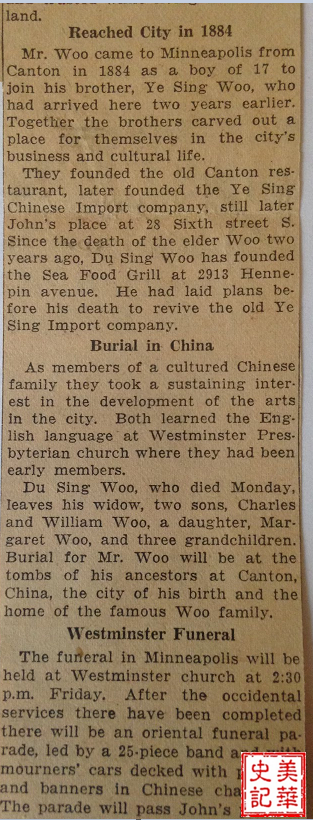
Photo from Honnay Molloy.
【7】
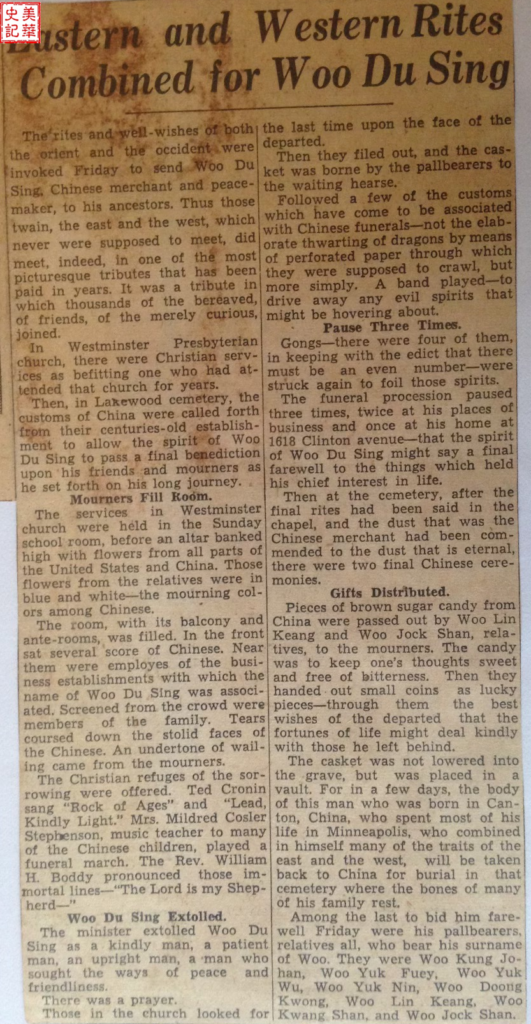
Photo from Honnay Molloy.
【8】Margaret Woo Chinn, interviews by Sarah Refo Mason, St. Paul, Aug. 29, 1979 (notes only), May 27, 1982.
【9】Jan Whitaker, 2019. Anatomy of a restaurateur: Woo Yee Sing. https://restaurant-ingthroughhistory.com/2019/06/16/anatomy-of-a-restaurateur-woo-yee-sing/
【10】
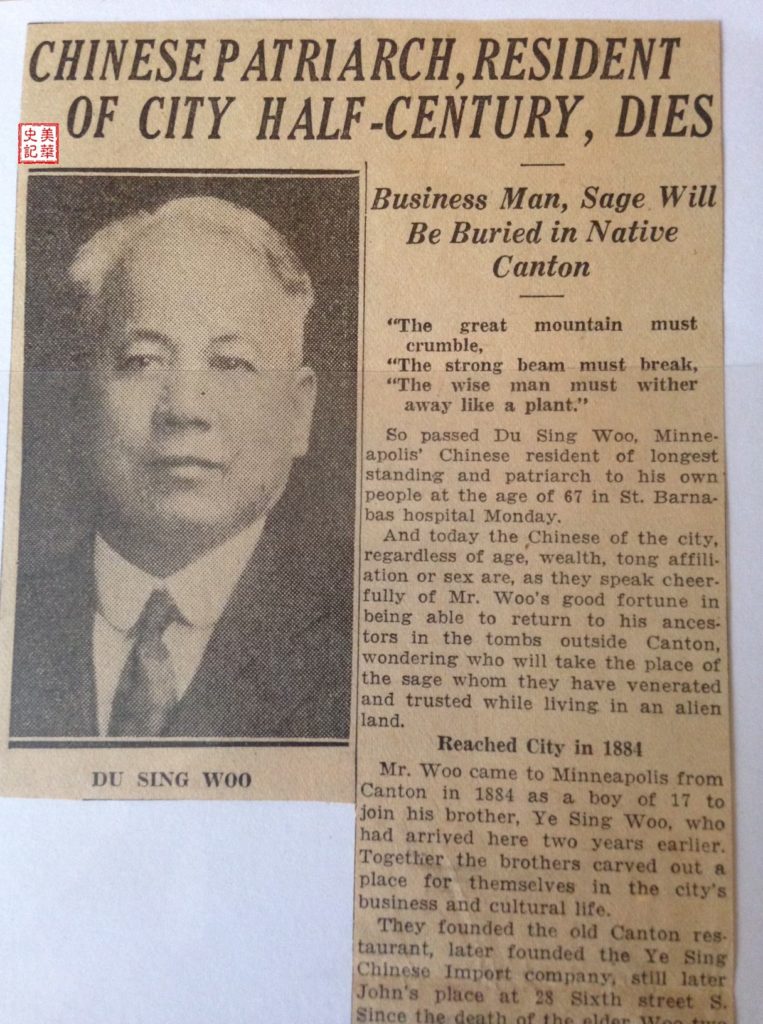
Photo from Honnay Molloy.
【11】Howard Woo, interviews by Sarah Refo Mason, St. Paul, Oct. 9, Oct. 15, 1981.
【12】SHERRI GEBERT-FULLER. YANG T’SU Chinese Altar from Minneapolis. http://collections.mnhs.org/MNHistoryMagazine/articles/56/v56i01p042-043.pdf
【13】Fuller, Sherri Gebert. Chinese in Minnesota. St. Paul: Minnesota Historical Society Press, 2004.
Well-written article: good resources and references. Sincerely, Dayna ( daughter of John Wong and Myrna Woo Wong who was the daughter of Charlie Woo)